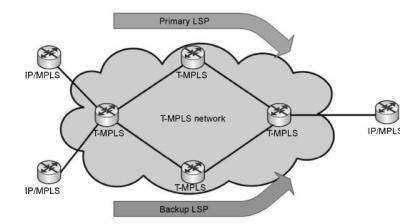T-MPLS technology Interpretation
8/16/15 | Technical Article
T-MPLS (Transport MPLS) is a connection-oriented packet transport technology. In the transport network, the client signal is mapped into the MPLS frame and use MPLS mechanisms (such as label switching, the label stack) forwards, while it increases the basic functions of the transport layer, such as connectivity and performance monitoring, survivability (protection and restoration), management and control plane (ASON/GMPLS). Overall, T-MPLS selected MPLS system in favor of some of the characteristics of data transmission services, abandoned the IETF (Internet Engineering Task Force) complex MPLS control protocol suite is defined, simplifying the data plane, remove unnecessary forwarding. T-MPLS inherit the characteristics and advantages of the existing SDH transport network, while a packet of service delivery to meet the needs of the future. T-MPLS and SDH uses a similar way they operate, which is especially important for large carriers, because they can continue to use existing network operations and management systems to reduce staff training costs. Since T-MPLS goal is to become a common packet transport network, without involving IP routing aspects of the function, therefore, T-MPLS implementations than IP/MPLS simple, including aspects of device implementation and network operations. T-MPLS is positioned to support the first major Ethernet service, but in fact it can support a variety of packet services and circuit-switched services, such as IP/MPLS, SDH and OTH like. T-MPLS is a connection-oriented network technology, using a subset of the features of MPLS.
The main function of T-MPLS features include:
(1) T-MPLS forwarding using a subset of MPLS: T-MPLS data plane retains the essential features of MPLS in order to achieve the interoperability of MPLS.
(2) transport network survivability: T-MPLS transport network supports the protection and restoration mechanism has, including 1+1, 1:1, ring protection and shared mesh recovery. MPLS FRR mechanism due to the use of LSP aggregation function without being adopted.
(3) transport network OAM mechanism: T-MPLS reference Y.1711 defined MPLS OAM mechanism, continue to use the OAM concepts and mechanisms widely used in other transport network, such as connectivity verification, alarm suppression, and remote defect indication and other.
(4) T-MPLS control plane: initial T-MPLS uses the configuration management plane, with the existing SDH network configuration in the same way. ITU-T currently has plans to adopt ASON/GMPLS as T-MPLS control plane, the next step will begin specific standardization work.
(5) Do not use the reserved label: any assignment given by the IETF responsible for labels, follow MPLS related standards, ensuring interoperability with MPLS.
Since T-MPLS is the use of a functional subset of MPLS to provide connection-oriented packet transport, and use the OAM mechanism to transport networks, therefore, T-MPLS canceled some connection with IP and non-business-related features of MPLS. The main difference between T-MPLS and MPLS are as follows:
(1) IP/MPLS router for IP networks, so that all nodes in the IP layer and supports MPLS layer forwarding data. The transfer only works in MPLS L2, so no forwarding IP layer.
(2) there is a lot of traffic in the short life cycle of IP/MPLS networks. In the Transport MPLS networks, the number of traffic streams is relatively small, relatively longer duration.
In particular realization of the function, the main difference between the two include:
(1) using bidirectional LSP: MPLS, and LSP is unidirectional, and transfer Netcom often use are two-way connections. Thus, T-MPLS will be two routes to the same, but in the opposite direction one-way LSP are combined into a two-way LSP.
(2) Do not use the penultimate hop popping (PHP) Options: PHP's purpose is to simplify export node processing requirements, but it requires export node supports IP routing function. In addition, since the data export node has no MPLS label, end to end OAM will cause difficulties.
(3) does not use LSP aggregation options: LSP aggregation refers to all the data packets through the same route to the same destination node can use the same MPLS label. While this can increase network scalability, but due to the loss of information and data sources, making OAM and performance monitoring difficult.
(4) do not use the same cost of multipath (ECMP) Options: ECMP allow the same LSP data flows through the network of a plurality of different paths. It not only increases the node apparatus on IP/MPLS header processing requirements, and because the performance monitoring data flow may go through different paths, so that it becomes difficult to OAM.
(5) T-MPLS OAM mechanism to support end to end.
(6) T-MPLS to support end to end protection switching mechanism, MPLS support local protection technology FRR.
(7) The pipe model is defined in RFC3443 and short pipe model processing TTL.
(8) Support RFC3270 the E-LSP and L-LSP.
(9) Support pipe model and short pipe model EXP approach.
(10) supported by a globally unique interface unique two label spaces.
 T-MPLS technology, MPLS, SDH, network, IP/MPLS, transport network, packet
T-MPLS technology, MPLS, SDH, network, IP/MPLS, transport network, packet


























